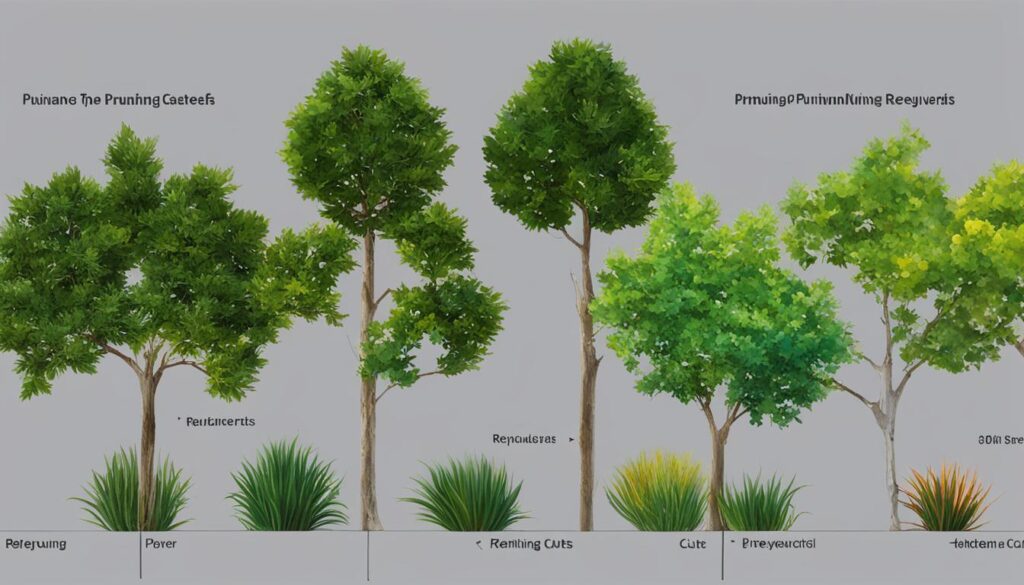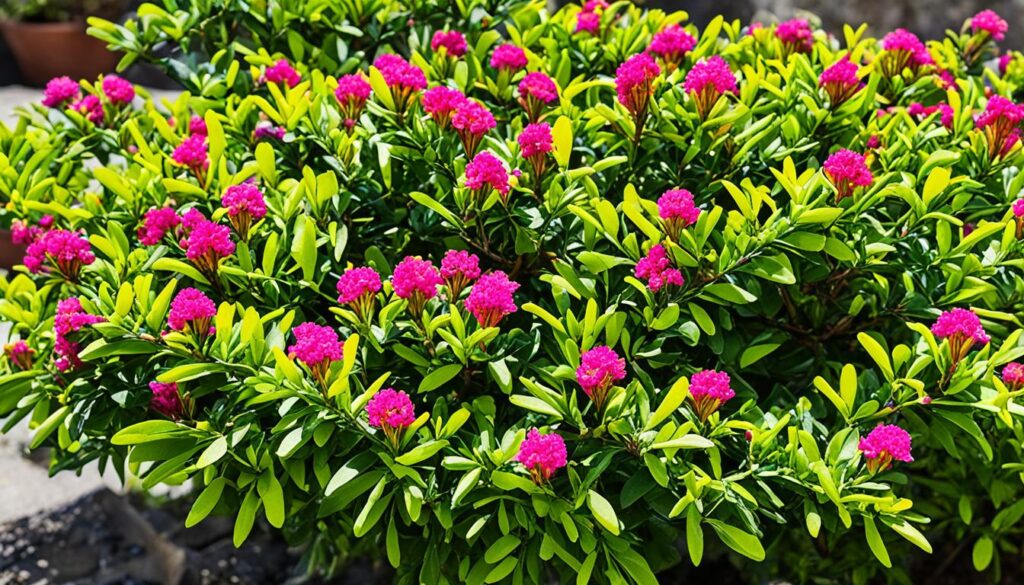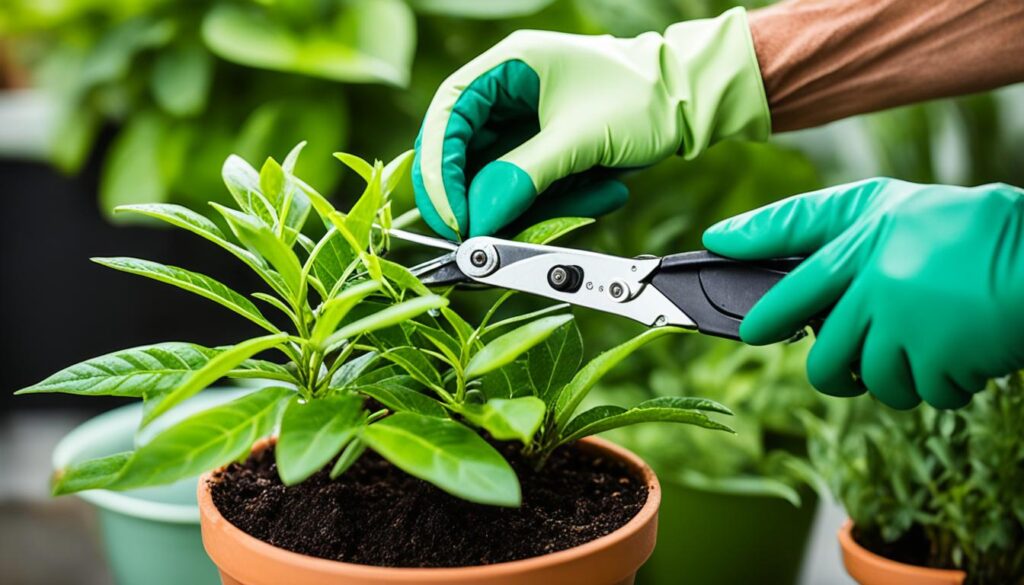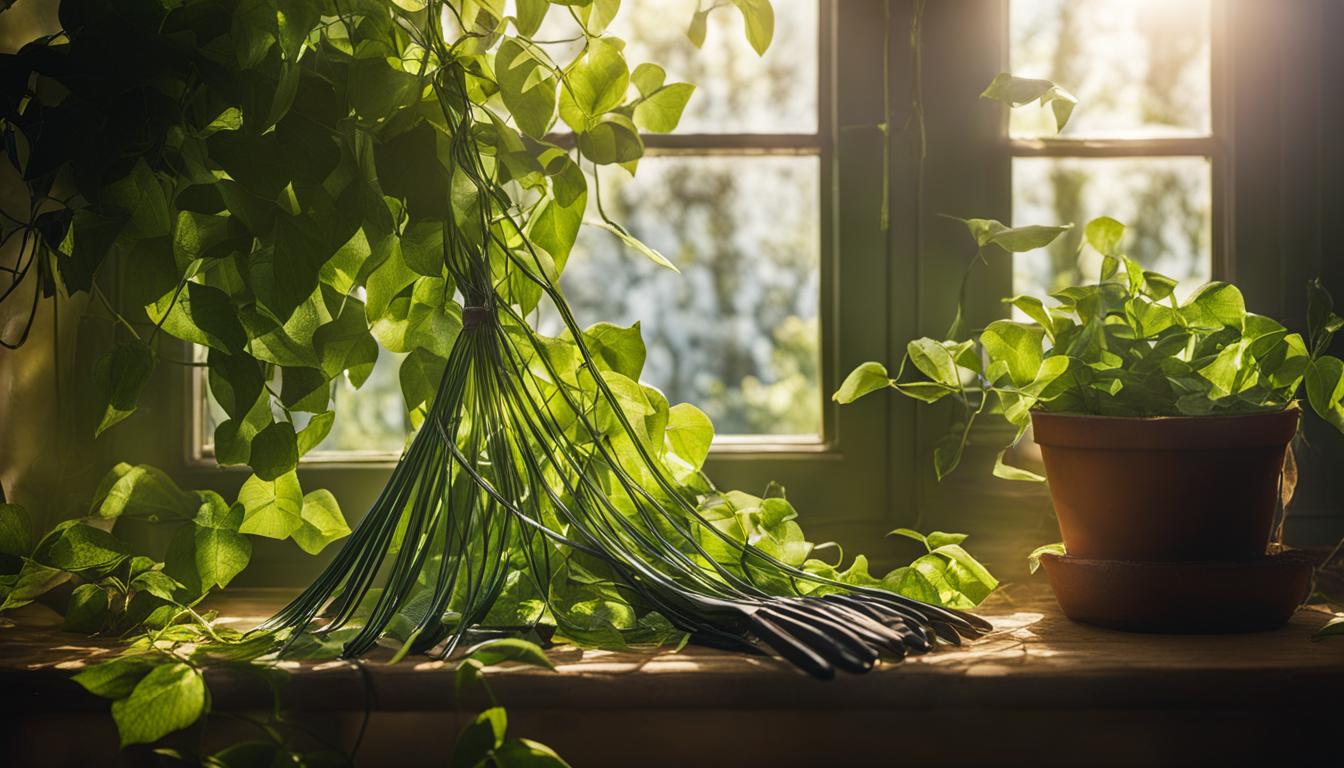Gardening enthusiasts know that proper pruning is essential for maintaining the health and beauty of plants. With the right techniques and methods, you can ensure that your plants thrive, producing lush foliage and abundant flowers. Whether you’re a seasoned gardener or just starting out, these trimming tips will help you achieve healthier and happier plants.
Key Takeaways:
- Follow professional pruning techniques for healthier plants.
- Use proper pruning methods to promote lush foliage and abundant flowers.
- Trimming tips can help you achieve successful pruning results.
- Expert plant trimming leads to stronger and more vibrant plants.
- Take care of your plants by applying effective pruning and care tips.
When to Prune
Pruning plays a crucial role in maintaining the health and beauty of your plants. However, it is important to prune at the right time to maximize the benefits for your plants. Understanding the timing of pruning, based on the plant’s growth season and bloom time, is key to successful pruning.
As a general rule, it is best to begin pruning after the first display of flowers and to stop pruning at the end of the plant’s growing season. This timing ensures that you do not disrupt the plant’s blooming cycle while allowing for adequate growth and development.
Pruning too late in the season can result in a delay in blooms, as the plant may not have enough time to produce new buds and flowers before the onset of winter. On the other hand, pruning too early can hinder the plant’s growth and reduce its overall vigor.
To determine the optimal pruning timing for your plants, it is essential to consider their specific growth season and bloom time. Different plants have different growth patterns and bloom times, so it’s important to familiarize yourself with the characteristics of each plant in your garden.
For example, spring-blooming plants, such as lilacs and forsythias, should be pruned immediately after they finish flowering. This allows the plant to set new buds for the next year’s blooms without interrupting its growth.
Pruning Timing for Common Plants
| Plant | Growth Season | Bloom Time | Optimal Pruning Timing |
|---|---|---|---|
| Rose | Spring to fall | Varies depending on the variety | Prune in early spring before new growth begins |
| Hibiscus | Spring to summer | Summer | Prune in early spring or after flowering in summer |
| Lilac | Spring to fall | Spring | Prune after flowering in spring |
| Hydrangea | Spring to summer | Summer | Prune after flowering in late summer or early spring |
| Azalea | Spring to fall | Spring | Prune after flowering in spring |
By understanding the growth season and bloom time of your plants, you can determine the best pruning timing to ensure healthy growth, abundant blooms, and overall plant vitality.
How to Prune
When it comes to pruning, understanding different techniques is essential for achieving your desired results. Whether you aim to promote new blooms, improve appearance, or maintain plant health, knowing the right approach is key. In this section, I will introduce you to various pruning techniques that will help you accomplish your goals.
Heading
Heading is a pruning technique that promotes new blooms and a fuller appearance. By cutting off dead and spent flowers and foliage, you can encourage the production of new stems, leaves, and flowers. This technique rejuvenates the plant, providing it with the energy it needs for continuous growth and vibrant blooms.
Thinning
To improve appearance and enhance flower size, thinning is an effective technique that reduces the size of overgrown and bulky plants. By selectively removing select branches or stems, you can create a more balanced and visually pleasing plant. Thinning also allows for better air circulation and light penetration, which promotes healthy growth.
Deadheading
Deadheading is an important technique for removing dead flowers, keeping your plants neat and stimulating further flowering. By snipping or pinching off spent blooms, you eliminate potential seed formation, redirecting the plant’s energy towards producing new flowers. Deadheading also helps maintain a tidy and well-groomed appearance in your garden.
Foliage Removal
Pruning dead or diseased foliage and stems is crucial for maintaining plant health. By removing affected parts, you prevent the spread of diseases and promote the growth of healthy foliage. Regular foliage removal also allows better air circulation and light exposure, further aiding in the overall well-being of your plants.
Now that you have a grasp of these essential pruning techniques, you can confidently approach your plant care routine. Remember to assess the condition of your plants and apply the appropriate technique based on their needs. With proper pruning, your plants will thrive, boasting lush foliage and stunning blooms.

| Pruning Technique | Goal |
|---|---|
| Heading | Promote new blooms and a fuller appearance |
| Thinning | Improve appearance and enhance flower size |
| Deadheading | Remove dead flowers and stimulate further flowering |
| Foliage Removal | Maintain plant health by removing dead or diseased foliage and stems |
Pruning for Extended Bloom and Re-blooming
Pruning plays a crucial role in extending the bloom period of your plants and promoting re-blooming. One effective technique for achieving an extended bloom period is deadheading. Deadheading involves the removal of faded or spent flowers, preventing the formation of seeds and redirecting the plant’s energy towards producing new flowers.
Many perennials benefit from deadheading, which leads to prolonged or repeat blooming. By consistently applying this technique, you can enjoy a continuous display of beautiful flowers throughout the growing season.

When deadheading, it’s important to use the proper technique to encourage new flower growth. To deadhead effectively:
- Identify the faded or spent flowers.
- Follow the stem down to the first set of healthy leaves or lateral bud.
- Use clean pruning shears or scissors to cut just above the leaves or bud.
Deadheading not only prolongs the blooming period but also maintains the overall appearance and health of your plants.
Benefits of Deadheading:
- Extended bloom period
- Repeat blooming
- Promotes new flower production
- Maintains the overall health and appearance of plants
By incorporating deadheading into your pruning routine, you can ensure that your plants continuously produce vibrant and fresh blooms, enhancing the beauty of your garden.
Stay tuned for the next section where I will discuss how to prune for compact growth and more flowers.
Pruning for Compact Growth and More Flowers
When it comes to achieving bushier plants with reduced height and more flowers, pinching is the go-to pruning technique. By selectively removing the tips of new growth, pinching encourages branching and results in fuller, more compact plants. This method is particularly beneficial for plants that tend to become leggy or require staking, allowing you to maintain the desired shape and size while increasing the number of blooms.
Pinching stimulates lateral bud growth, promoting the development of multiple stems and branches. As a result, the plant becomes bushier and denser, filling out any empty spaces in your garden bed. Additionally, by reducing the plant’s height through pinching, you can create a more harmonious and visually appealing arrangement.
Pinching is a simple yet powerful technique that can transform the growth habits of your plants. By selectively removing new growth tips, you can stimulate branching and encourage bushier growth, resulting in a more abundant display of flowers.
This technique is especially effective for herbaceous plants such as coleus, basil, and mums, which tend to elongate and become leggy over time. Pinching these plants regularly helps maintain compact growth and prevents them from becoming too tall and floppy.
Promoting Flowering with Pinching
In addition to promoting compact growth, pinching also stimulates flowering. By removing the tips of new growth, the plant redirects its energy from vertical growth to flower production, resulting in an increased number of blooms. This method is particularly useful for plants that tend to produce tall, single stems with few flowers.
When pinching, focus on removing the terminal bud, which is located at the tip of each stem. This encourages the plant to produce lateral buds along the stem, resulting in multiple blooms. Regular pinching throughout the growing season can lead to continuous flowering, prolonging the plant’s blooming period and enhancing its overall beauty.
How to Pinch
Pinching is a straightforward and easy technique that can be done by hand or with pruning shears. When pinching, follow these simple steps:
- Identify the areas of new growth that you want to remove.
- Using your fingers or pruning shears, pinch or cut off the tips of the new growth.
- Make the cut just above a node, which is the point where leaves or buds emerge from the stem.
- Continue pinching regularly to maintain the desired shape and promote bushier growth.
Remember to practice caution when pinching, as excessive or improper pinching can hinder plant growth and delay or reduce flowering. It’s important to be mindful of the specific needs and characteristics of each plant to achieve optimal results.
With the pinching technique, you can effectively shape your plants, control their height, and stimulate abundant flowering. By incorporating pinching into your pruning routine, you’ll be on your way to creating a garden filled with lush, compact plants bursting with vibrant blooms.

Pruning for Stronger Plants and Improved Health
Pruning plays a crucial role in stimulating new growth stimulation and improving the overall health of your plants. Removing old or tatty growth promotes the emergence of fresh growth promotion from the base of the plant. This new growth contributes to the overall appearance of the garden and helps rejuvenate tired or damaged plants.
By pruning back the old growth, you can encourage lush and healthy new growth, which enhances the vitality and vigor of your plants. Regular pruning not only stimulates new growth stimulation, but it also allows for the removal of diseased or damaged parts of the plant, promoting better overall health.
“Pruning is like giving your plants a fresh start. It allows them to shed the old and make way for vibrant, fresh growth promotion.”
Pruning also provides an opportunity to shape and direct the growth of your plants. By selectively removing branches and stems, you can encourage a more desirable form and prevent overcrowding. This promotes better air circulation and light penetration, reducing the risk of disease and promoting overall plant health.
When pruning, it is important to use the correct tools and techniques to ensure clean cuts and minimize damage to the plant. Sharp pruning shears, loppers, or pruning saws are essential for precise cuts. Additionally, it is important to sanitize your tools between cuts to prevent the spread of disease.
| Benefits of Pruning for Stronger Plants and Improved Health |
|---|
| Promotes new growth stimulation |
| Removes old or tatty growth |
| Rejuvenates tired or damaged plants |
| Enhances overall appearance of the garden |
| Increases vitality and vigor of plants |
| Shapes and directs plant growth |
| Improves air circulation and light penetration |
| Reduces the risk of disease |
By incorporating regular pruning into your plant care routine, you can ensure that your plants stay strong, healthy, and beautiful.
Pruning for Double Bloom Time
By strategically pruning your plants, you can create a stunning display of flowers that bloom twice and add unique visual interest to your garden. This technique involves carefully cutting back or pinching portions of a group of perennials to manipulate their blooming times and heights. The result is a dynamic and prolonged flowering show, with different sections of your garden blooming earlier or later than others.
Staggered blooming allows you to enjoy a continuous parade of vibrant blooms throughout the growing season, creating a captivating and ever-changing landscape. The variation in height adds further dimension to your garden design, adding depth and structure to the overall composition.
To achieve staggered blooming, start by identifying groups of plants that bloom in the same season. By selectively pruning some plants, you can manipulate their flowering times and create a beautiful contrast within the group. Trim back a portion of the plants to encourage earlier blooming, while leaving other plants untouched to bloom later. This way, you can stage and extend the flowering period, making a statement with the gradual unfolding of colors and forms.
“Staggered blooming allows you to enjoy a continuous parade of vibrant blooms throughout the growing season, creating a captivating and ever-changing landscape.”
In addition to timing, height variation plays a crucial role in adding visual interest to your garden. By selectively cutting back the taller plants within a group, you can create a layered effect, with shorter blooms peeking out from underneath the taller ones. This height variation creates a sense of depth and texture, making your garden more visually appealing.
Flowering manipulation through selective pruning requires careful observation and planning. Consider the growth habits of each plant and the desired effect you wish to achieve when deciding which plants to prune and when. Experimenting with different pruning techniques can help you find the optimal balance between staggered blooming and height variation for your garden.
With the strategic use of pruning techniques, you can create a garden that blooms twice and captures attention with its artistic composition. The double bloom time achieved through staggered blooming and height variation adds a touch of magic to your outdoor space, providing an ever-changing display of colors and textures that will captivate both you and your guests.

Pruning Tips for Specific Plants
Different plants have different pruning needs and requirements. It is essential to understand the specific pruning needs of different plant species to maximize their growth and overall health. By tailoring your pruning techniques accordingly, you can enhance flower size, fruit production, and ensure continuous blooming.
Fruit Trees
Pruning fruit trees is crucial for enhancing fruit production and maintaining the tree’s overall health. Here are some tips:
- Prune during the dormant season, usually in late winter or early spring, before the tree starts to bud.
- Remove any damaged or diseased branches to prevent the spread of pests and diseases.
- Thin out overcrowded branches to increase airflow and sunlight penetration.
- Prune to shape the tree and promote a strong and balanced framework.
Roses
Roses can benefit from specific pruning techniques to encourage continuous flowering. Follow these tips for successful rose pruning:
- Prune roses in early spring before new growth emerges.
- Remove any dead, damaged, or diseased branches to maintain plant health.
- Prune to an outward-facing bud to encourage the growth of new stems and flowers.
- Regularly deadhead faded flowers to stimulate the production of new blooms.
Shrubs and Bushes
Pruning shrubs and bushes can help maintain their shape, promote better flowering, and control their size. Consider the following tips:
- Prune flowering shrubs immediately after they bloom to avoid removing next season’s flower buds.
- Trim back overgrown or leggy branches to encourage bushier growth.
- Thin out crowded branches to improve air circulation and light penetration.
- Regularly remove any dead or damaged branches to maintain plant health.
General Tips for Specific Plant Pruning
Regardless of the plant species, keep these general tips in mind when pruning:
- Use clean and sharp pruning tools to ensure a clean cut, reducing the risk of disease transmission.
- Do not remove more than one-third of the plant’s growth during a single pruning session.
- Observe the natural growth habit of the plant and prune to maintain its natural shape.
- Regularly monitor your plants for signs of pests, diseases, or any abnormal growth, and take corrective pruning measures accordingly.
Remember, proper pruning techniques specific to each plant can significantly contribute to enhanced flower size, fruit production, and overall plant health. Now let’s take a look at a table that summarizes the pruning tips discussed:
| Plant | Pruning Tips |
|---|---|
| Fruit Trees | Prune during dormant season, remove damaged branches, thin out overcrowded branches, shape the tree |
| Roses | Prune in early spring, remove dead and diseased branches, prune to an outward-facing bud, regularly deadhead faded flowers |
| Shrubs and Bushes | Prune after blooming, trim back overgrown branches, thin out crowded branches, remove dead or damaged branches |
By following these pruning tips, you can ensure that each plant receives the care it needs and enjoy the beautiful results of your efforts.
Conclusion
Pruning is essential for the health and beauty of your plants. By following professional techniques and methods, you can achieve success in plant care and create lush, thriving plants that bring joy and beauty to your garden.
When pruning, it is crucial to consider the timing and choose the right technique for each plant. Understanding the growth season and bloom time of your plants will help you determine the best time to prune. Whether it’s deadheading to promote blooming or thinning to improve appearance, each technique serves a specific purpose in maintaining your plants’ health.
With proper pruning, you can promote growth, reduce height, and enhance blooming. By removing dead or tatty growth, you stimulate fresh growth and rejuvenate tired or damaged plants. Additionally, strategically pruning certain perennials can create staggered blooming times and add depth and dimension to your garden design.
In conclusion, mastering the art of pruning is key to successful plant care. By following professional techniques and methods, you can ensure the health, vitality, and beauty of your plants year-round. Prune like a pro, and enjoy the rewards of a thriving garden.
FAQ
Why is pruning important for plant health?
Pruning is crucial for maintaining the health and beauty of your plants. It promotes new growth, removes dead or diseased foliage, and improves overall plant vitality.
When is the best time to prune plants?
Pruning should generally be done after the first display of flowers and before the end of the plant’s growing season. The timing may vary depending on the plant type and bloom time.
What are the different pruning techniques?
There are various pruning techniques, including heading, thinning, deadheading, and foliage removal. Each technique serves different purposes such as promoting new blooms, improving appearance, and maintaining plant health.
How does deadheading benefit plants?
Deadheading, or the removal of faded flowers, prevents seed formation and encourages the plant to produce new flowers. It can lead to prolonged or repeat blooming, resulting in a continuous display of flowers throughout the growing season.
What is pinching, and how does it promote compact growth and more flowers?
Pinching involves removing the tips of new growth to encourage branching, resulting in a bushier and more compact plant. This technique stimulates more flower production and reduces the height of the plant.
How does pruning contribute to strong and healthy plants?
Pruning plays a vital role in stimulating new growth and removing old or tatty growth. By pruning, you can promote the emergence of fresh, lush growth, contributing to the overall health and appearance of the plants.
How can pruning create a double bloom time?
By selectively cutting back or pinching portions of a group of perennials, you can stagger their blooming times and heights. This technique adds depth and dimension to your garden, resulting in a prolonged display of flowers.
Are there specific pruning tips for different types of plants?
Yes, different plants have specific pruning needs. Fruit trees may require pruning techniques to enhance fruit production, while roses may benefit from specific deadheading techniques. Understanding the needs of each plant will help you tailor your pruning approach.
How important is pruning for successful plant care?
Pruning is a fundamental aspect of plant care that significantly impacts plant health and appearance. By following proper pruning techniques, you can achieve healthier and happier plants that bring joy and beauty to your garden.

